This task shows you how to identify duplicate elements in a
mesh.
Duplicate elements are elements sharing exactly the same nodes.
The duplicate elements will be red-highlighted, other elements (elements that are not duplicated) will be green-highlighted.
Open the sample29.CATAnalysis document from the samples directory.
This example contains two surface mesh parts (each mesh part contains one quadrangle element) and one of the Surface Mesh.2 mesh part is built with mesh capture.
-
Click Duplicate Elements
 in the Mesh Analysis Tools toolbar.
in the Mesh Analysis Tools toolbar.The Duplicate Elements dialog box appears.
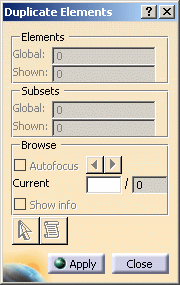
-
Elements: gives you the number of duplicate elements.
-
Global: gives you the total number of duplicate elements (hidden and shown duplicate elements).
-
Shown: gives you the number of duplicate elements that are shown (if a duplicate element belongs to a hidden mesh part, this element is not taken into account).
-
-
Subsets: gives you the number of sets containing duplicated elements.
-
Global: gives you the total number of sets (hidden and shown sets).
-
Shown: gives you the number of sets that are shown (if a set is hidden, this set is not taken into account).
-
-
Browse: lets you auto-focus and show information on the visible duplicate subsets.
-
Autofocus: lets you localize easily visible duplicate elements by focus on them.
-
Current: gives you the number of detected duplicate elements and lets you visualize a particular duplicate element either by entering a number or by clicking the browse buttons.
-
Show information: lets you display information about visible duplicate subsets.
-
-
Select duplicate entity
 : lets
you display information about a duplicate element.
: lets
you display information about a duplicate element.
If you click this button, the Duplicate Element dialog box appears.
This button is available only if at least one duplicate element has been found.
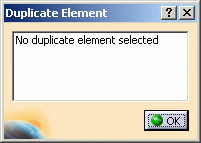
Then you have to select a duplicate element to fill this dialog box.
-
Generate Report
 :
lets you export duplicated element data including centroid and mesh
part names in a .html file.
:
lets you export duplicated element data including centroid and mesh
part names in a .html file.
If you click this button, the Report Generation dialog box appears.
This button is available only if at least one duplicate element has been found.
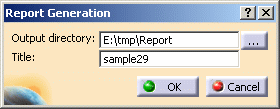
-
Output directory: lets specify the directory in which the report file will be stored.
-
Title: lets you modify the name of the report file.
-
-
-
Click Apply.
The Duplicate Elements dialog box is updated:
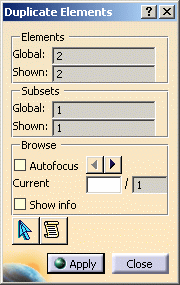
And the duplicate elements are red highlighted.
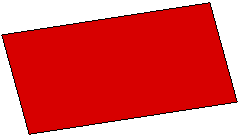
-
Click Select duplicate entity
 .
. -
Select a duplicate element.
In this particular example select the Surface Mesh.2 mesh part.
The Duplicate Element dialog box is automatically updated with the following information:
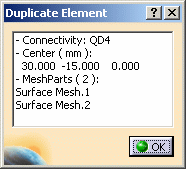
-
Click OK.
-
Click Generate Report
 .
. -
Choose the directory and the title of the report file.
-
Click OK.
The .html report is automatically displayed:
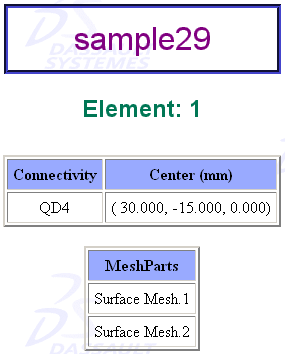
-
Click Close in the Duplicate Elements dialog box.
Note that in this particular example, no intersection and
no interference has been found.
For more details about intersection and interference, refer to
Checking Intersections / Interferences.
Open the sample29_1.CATAnalysis document from the samples directory.
This example contains two surface mesh parts build with internal nodes. Each mesh part contains eight quadrangle elements.
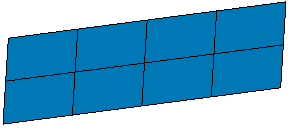
-
Click Duplicate Elements
 in the Mesh Analysis Tools toolbar.
in the Mesh Analysis Tools toolbar. -
Click Apply.
The Duplicate Elements dialog box is updated:
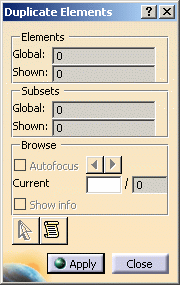
And the duplicate elements are green highlighted.
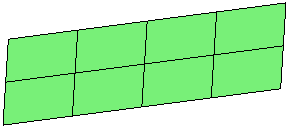
This means that there is no duplicate element.
-
Click Close.
-
Click Intersections / Interferences
 in the Mesh Analysis Tools toolbar.
in the Mesh Analysis Tools toolbar. -
Enter 0mm as Clearance value and click Apply.
The Interference Check dialog box shows you that 16 elements are in intersection.
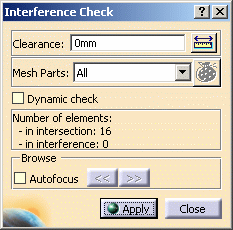
-
Click Close.
![]()